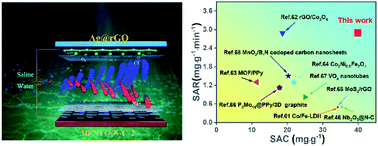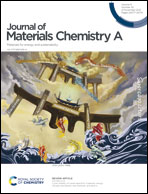Boosting deionization capability by effectively improving sodium-ion storage capacity based on robust interfacial electronic interaction within 3D Na4Ti9O20/N-doped porous carbon heterostructures†
Abstract
A novel preparative approach for promising cathode materials for capacitive deionization (CDI) is proposed. Several 3D Na4Ti9O20/N-doped carbon composite materials (3D NTO/N-C-x, x represents the hydrothermal reaction time) with high surface area are synthesized by pyrolysis of Ti-based metal–organic frameworks (Ti-MOFs) and a subsequent hydrothermal treatment strategy. Notably, the intrinsic interfacial interaction of the optimized 3D NTO/N-C-2 facilitates the synergy of the internal driving field and condensed phase interface, which is greatly beneficial to obtain more active sites for sodium ion storage and improved storage capacity (249 F g−1 at 1 A g−1). Furthermore, an all-faradaic-type 3D NTO/N-C-2//Ag@rGO full desalination cell shows high salt adsorption capacity (59.3 mg g−1) and stable cycling desalination ability (95% capacity retention rate over 20 cycles at 1.4 V). In addition, the mechanism of the zwitterion removal/release of the desalination cell is thoroughly investigated by electrochemical measurement. This work not only provides a reasonable strategy to establish cathode materials for CDI, but also may trigger the rapid development of Ti-based electrode materials in many frontier fields.



 Please wait while we load your content...
Please wait while we load your content...